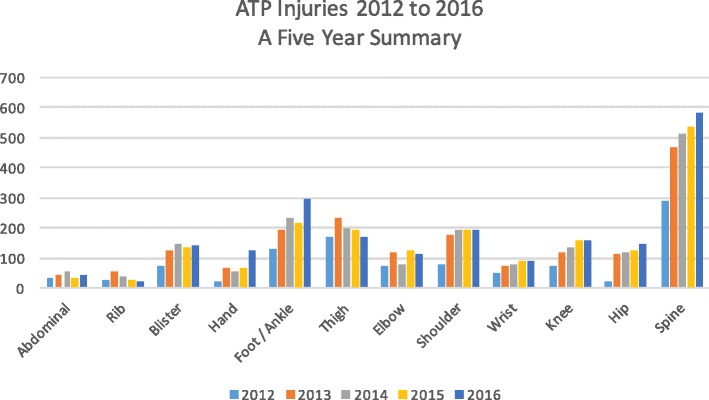by Dr. Callan Martin DC, CCSP®, ICSC

Tennis, with its explosive movements and repetitive actions, can take a toll on the body, leading to various injuries that plague players of all levels. In this article, we delve into the most common tennis injuries encountered by both professionals and amateurs alike.
Tennis is one of the most popular sports in the world. It is a fairly inexpensive sport to engage with and tennis courts are plentiful. There are an estimated 23.6 million tennis players in the USA as of 2023, a growth of over 30% since 2020. (1) As with other sports the thrill and fun comes with a potential downfall, injuries to the player’s body. Our office sees many athletes participating in a diverse variety of sports. As the popularity of raquet sports increases, so is the instance of tennis related injuries to our office. Our staff prides itself in advanced sports medicine training to not only treat sports injuries but screen the athlete in order to improve the efficiency and durability to decrease probability of injury.
Tennis is a unique sport in that the matches have no pre-determined time limit. Some matches may last for hours and weigh heavily on the player’s endurance and efficiency of movement. Forces travel through the player’s kinetic chain. The kinetic chain is the connection between various muscles, joints and other connective tissue where force may travel.
Tennis players are prone to various injuries, some are biased to the experience and biological sex of the player. We will examine the most frequently experienced injuries in both elite professional and amateur tennis players.

Five-year summary of injury region in male professional tennis players (with permission from ATP, unpublished data)
Professional American Tennis Professionals
1. Lower Back Pain:
Statistically, the most common tennis injury is…. Back pain. The explosive movements and rotational forces involved in tennis can place strain on the lower back, leading to pain and discomfort. Factors such as poor posture, improper technique, and muscle imbalances can exacerbate the risk of lower back injuries. Core strengthening exercises, flexibility training, spinal alignment and proper body mechanics are essential for preventing and managing lower back pain in tennis players.
2. Ankle Sprains:
The dynamic movements involved in tennis, including sudden stops, starts, and changes of direction, increase the likelihood of ankle sprains. Whether it’s chasing down a drop shot or pivoting to return a powerful forehand, players often subject their ankles to significant stress. Ankle sprains occur when the ligaments surrounding the ankle joint are stretched or torn, leading to pain, swelling, and instability. Proper strength, body control, joint alignment and muscle balance are essential for preventing ankle injury.
3. Shoulder Injuries:
The serve, a fundamental aspect of tennis, places significant stress on the shoulder joint, making it susceptible to injuries such as rotator cuff tears, tendonitis, and impingement syndrome. These injuries can result from poor technique, overexertion, or muscle imbalances. Proper warm-up, strength training, and technique refinement can help reduce the risk of shoulder injuries in tennis players.
4. Thigh Injuries:
Sudden starts and stops, change of direction and jumping all place load through the front and back of the thigh. Thigh injuries, such as strains and muscle pulls, can occur due to overuse, inadequate warm-up, poor conditioning, and biomechanical issues. Proper warm-up, flexibility work, strength training and cross-training will all help prevent injury.
5. Knee Injuries:
Tennis places considerable demands on the knees, particularly during lateral movements and quick changes in direction. Common knee injuries in tennis players include patellar tendonitis (also known as jumper’s knee), meniscal tears, and anterior cruciate ligament (ACL) injuries. These injuries can result from repetitive stress, poor biomechanics, or sudden impacts.
6. Tennis Elbow (Lateral Epicondylitis):
Thought this one would be closer to the top? Tennis elbow is perhaps the most infamous injury associated with the sport, affecting players of all levels. It occurs due to overuse of the forearm muscles, leading to inflammation and pain on the outside of the elbow. While it’s commonly associated with tennis due to the repetitive gripping and swinging motions, it can also affect individuals engaged in other activities involving repetitive arm movement.
Amateur Tennis Players (College, Recc. and Juniors)
NCAA data shows a higher rate of injury during competition versus practice. Women suffer a slightly lower injury rate 8.9/1000 for men and 7.4/1000 for women over 1,000 athletic events.
When we look at Junior elite players, it is noted that as the athlete gets older, the chance of injury increases. Injury rates were 11% in the 12 and underage group, 28% in the 14 and underage group, and 36% in the 16 and underage group. In terms of body region, the back, shoulder, ankle, knee, and wrist were the most commonly reported regions of injury among the 861 elite junior tennis players studied.
Recreational players were found to suffer more injuries to the ankle, knee, lower back and shoulder. Players who recreationally play often do not possess the proper athletic conditioning, balance and proper form. Proper strength training and gradual increase in intensity of play allows the body to develop resistance to injury. Training with an experienced tennis pro will help to identify poor movements that may lead to injury. Finally, incorporating a good warm-up to release stiff, tight muscles and lubricate joint surfaces will aid in prevention of injury as well.
Prevention and Management
While injuries are an inherent risk in tennis, there are several measures players can take to reduce their likelihood and mitigate their impact. Proper warm-up and cool-down routines, adequate rest and recovery, cross-training to address muscular imbalances, and technique refinement under the guidance of a qualified coach are crucial aspects of injury prevention. Additionally, listening to one’s body, recognizing early warning signs, and seeking prompt medical attention can aid in the timely management of injuries, preventing them from escalating into more serious issues.
Chiropractic Care for Tennis Injuries
The providers of our office are trained to evaluate and manage common sports injuries. Chiropractors and other sports medicine professionals may also identify movment restrictions or dysfunction through the joints of the body that may lead to poor performance or injury. Seeking care from a chiropractor trained in injury treatment and prevention may help you ace your tennis game!
Our office accepts most insurances and chiropractic care for joint injuries is covered under most plans. If you are seeking care for preventative care or wellness care, we have very reasonable self-pay options.
1. U.S. tennis participation grew for third straight year in 2022. USTA. Accessed March 20, 2024. https://www.usta.com/en/home/stay-current/national/u-s–tennis-participation-grew-for-third-straight-year-in-2022.html.
2. Fu MC, Ellenbecker TS, Renstrom PA, Windler GS, Dines DM. Epidemiology of injuries in tennis players. Current reviews in musculoskeletal medicine. March 2018. Accessed March 20, 2024. https://www.ncbi.nlm.nih.gov/pmc/articles/PMC5825333/.
Last Edited: 03/20/2024
About the Author:

Dr. Callan Martin DC, CCSP®, ICSC is a sports chiropractor in Overland Park, Kansas, USA. He holds advanced certifications in sports medicine, treating and preventing sports injuries and a strength coaching certification through the National Strength and Conditioning Association. Over his 13+ years of experience, he has treated athletes ranging from professional to youth and recreational athletes. He has a passion for treating patient who are active and have a passion for sports. Although a very recreational athlete himself, he has personal experience with devestating sports injuries and how to recover from them. He currently practices at Back On Track Chiropractic + Acupuncture in Overland Park.

